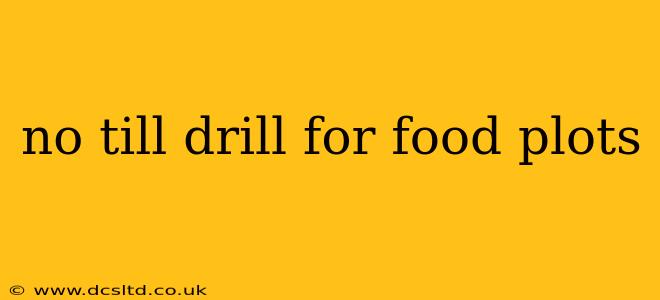Creating thriving food plots for wildlife requires careful planning and execution. One crucial element is the planting method, and increasingly, no-till drilling is becoming the preferred approach for its numerous benefits. This guide delves into the advantages of using a no-till drill for food plots, explores different types available, and provides advice on successful implementation.
What is a No-Till Drill?
A no-till drill is a specialized piece of equipment designed to plant seeds directly into undisturbed soil. Unlike conventional tillage methods that plow or disc the land, a no-till drill utilizes coulters or openers to create narrow slits in the soil, depositing seeds and covering them without disrupting the soil structure. This minimal soil disturbance preserves soil health, reduces erosion, and creates a more favorable environment for seed germination and plant growth.
Advantages of Using a No-Till Drill for Food Plots
The benefits of using a no-till drill for establishing food plots are substantial:
- Soil Health Improvement: No-till drilling maintains soil structure, promoting beneficial microbial activity and increasing organic matter. This leads to improved water infiltration, nutrient retention, and overall soil fertility.
- Erosion Control: By minimizing soil disturbance, no-till drilling significantly reduces erosion, especially on slopes or areas prone to wind erosion. This protects valuable topsoil and prevents nutrient loss.
- Weed Control: While not a complete solution, the minimal soil disturbance can help suppress some weed growth, particularly annual weeds. Combined with herbicide applications (if needed and allowed in your area) this can be very effective.
- Time and Cost Savings: No-till drilling is generally faster than traditional tillage methods, saving time and fuel costs.
- Improved Water Management: The undisturbed soil structure in no-till systems enhances water infiltration and retention, leading to better drought tolerance for planted species.
- Increased Biodiversity: The healthier soil in no-till systems often supports a greater diversity of beneficial insects and microorganisms.
Types of No-Till Drills for Food Plots
Several types of no-till drills are available, each with its own features and capabilities:
- Small-Scale Drills: These are ideal for smaller food plots and are often manually operated or attached to ATVs or small tractors. They're perfect for the home wildlife enthusiast.
- Larger Drills: Designed for larger-scale operations, these drills are typically pulled by tractors and can plant wider swaths, increasing efficiency significantly. Consider the size of your food plots when making your selection.
- Grain Drills Adapted for Food Plots: Some standard grain drills can be adapted for food plot use with minor modifications. Be sure to check the drill's specifications to ensure it's suitable for your seed type and planting depth.
What Seed Types Work Best with No-Till Drills?
No-till drills are effective with a wide variety of seeds, including:
- Small Seeds: Forage grasses, clovers, and legumes generally perform well with no-till drilling.
- Larger Seeds: Some larger seeds, such as soybeans or corn, can also be planted with no-till drills, though you may need to adjust the settings accordingly.
How to Use a No-Till Drill for Food Plots: A Step-by-Step Guide
- Site Preparation: While minimal, some preparation is still necessary. Clear the area of large debris and rocks that could damage the drill.
- Seed Selection: Choose seeds appropriate for your region, soil type, and target wildlife species. Consider seed-to-soil contact to ensure germination.
- Drill Calibration: Carefully calibrate the drill to ensure the correct seed spacing and planting depth. Test runs are crucial to avoid over-seeding or shallow planting.
- Planting: Operate the drill at the recommended speed and depth, paying attention to ensure consistent seed distribution.
- Post-Planting: Lightly pack the soil around the seeds if necessary (some drills accomplish this automatically). Consider a light fertilizer application if soil testing reveals deficiencies.
H2: What are the disadvantages of using a no-till drill for food plots?
While the advantages are numerous, it's important to acknowledge potential drawbacks:
- Initial Cost: No-till drills can be a significant investment, particularly larger models.
- Learning Curve: Mastering the use of a no-till drill requires practice and some technical understanding.
- Potential for Seed Damage: If not properly calibrated, the drill could damage seeds, reducing germination rates.
- Weed Pressure: While no-till can suppress some weeds, others may thrive if not managed correctly. Proper weed control strategies are important.
H2: Is a no-till drill better than a broadcast spreader for food plots?
Both methods have their place, but no-till drilling generally offers superior results, especially in terms of soil conservation and germination rates. Broadcast spreaders waste seeds, and many seeds fail to find suitable contact with the soil. This makes for lower success rates and often necessitates over-seeding.
H2: What are some common mistakes to avoid when using a no-till drill?
- Improper Calibration: This is arguably the most common mistake, leading to inconsistent seeding and poor germination.
- Incorrect Planting Depth: Too shallow, and seeds may not receive enough moisture or protection; too deep, and seeds may not germinate.
- Ignoring Soil Conditions: Planting in extremely dry or compacted soil can reduce success rates.
By carefully considering the factors outlined above and employing best practices, you can successfully utilize a no-till drill to establish thriving and sustainable food plots that will benefit wildlife for years to come. Remember to tailor your approach to your specific needs and conditions for optimal results.
